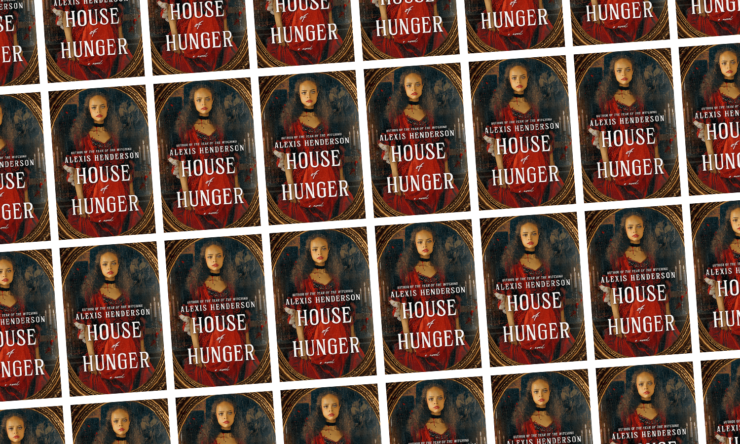Everyone currently freaking out about the new Interview With the Vampire TV show, have I got a novel for you. While Alexis Henderson’s latest dark fantasy novel House of Hunger is only vampire adjacent, it’s sexy and queer and monstrous and very bloody.
In Prane, Marion Shaw’s life is one of perpetual drudgery. Her job working as a maid for a bitter, brittle old woman has crushed her dreams, but it’s better than ruining her health in a factory. Better, but not by much. Prane is in the South where industry is king and old money lordlings are a thing of the past. They look down in scorn at the backwards, old fashioned Northerners as much as the Northerners lift their noses at the rough and tumble, filthy South.
Desperate for something more, she applies for a job as a bloodmaid in one of the distant Northern Houses. In the North, bloodmaids are highly praised. To Marion a bloodmaid seems like someone who is half housemaid and half queen’s consort, an indentured servant in title but a bride in practice. Marion accepts a position with Countess Lisavet, the head of the House of Hunger, one of the oldest Houses in the North. At first things seem fine, if a little odd. A stray tooth turns up in her bedroom. One of her fellow bloodmaids is strung too tight and wields her spite like a sword. Lisavet is as mercurial as a snowstorm, sometimes loving and seductive while others cold and dismissive. Marion thrills at being lured into Lisavet’s bed and begins to dream of a future at her lover’s side.
Buy the Book


House of Hunger
But soon, blood begins to seep through the seams of Marion’s flimsy fantasy. A bloodmaid goes mad and one of the household staff goes missing. A lord wants to stake his claim on Lisavet’s throne. Secrets burst from their graves and terrible truths try to pull the bloodmaids down into hell. Marion has faced death before, but never has its claws been gripped so tight around her throat.
Henderson keeps a tight focus on Marion throughout the novel, somewhat to the detriment of the story as a whole. We hardly learn anything about the world, the other Houses, or the other characters. Even Lisavet herself remains as much of an enigma to the reader as she does Marion. We get a few facts about her childhood, but I strongly suspect she would be exactly the same shade of cruel regardless of whether or not she went through those trials.
The book also needed more worldbuilding around the Houses. Henderson prefaces each chapter with a quote from a different bloodmaid, but those quotes carry little weight because the reader has no idea who those bloodmaids are or anything about the Houses where they were indentured. There are also some inter-House squabbles going on in the background that don’t leave much impact. Marion often comments on the cultural differences between the South, where she’s from, and the North, where Lisavet lives, but, again, because Marion doesn’t—can’t—venture beyond the walls of the House of Hunger and because Henderson chooses to not share whatever knowledge of the North Marion learns during her tutelage, her comments mean little to the reader. What we do see of the world is fascinating and compelling. More worldbuilding would have taken a very good book and made it great.
The only complaint I had with Henderson’s first book, the excellent Year of the Witching, was that the ending lacked the punch that the rest of the story deserved. With House of Hunger, she has resolved that issue; the ending is intense and bloody, a frightening peak after a painful uphill battle. However, this go ‘round, it’s the middle that sags. It needed another confrontation to keep the tension pulled taught, perhaps with Sir Ivor, a character who doesn’t get nearly enough to do to make his final interaction with Marion mean as much as it should.
I appreciated how queerness here is simply one way of existing in the world. There is no word for queer because they don’t need one. People are attracted to whoever they’re attracted to and no one cares one way or the other. Marion feels no shame in having passionate, pleasurable sex with women and never considers concealing that part of her identity. Out of all the things people attack her for being interested in her same gender never comes up. Race doesn’t seem to be a major factor of oppression either, although Marion notes that she and another Black girl have to do their own hair because the Northern Houses, with their predominantly white population, don’t know what to do with curls.
House of Hunger is a killer sophomore novel from Alexis Henderson. She has more than earned her place on my list of auto-read authors. Fans of gothic horror, sexy blood drinkers, and sapphic fantasy should move this to the top of their TBR.
House of Hunger is published by Ace.
Alex Brown is a Hugo-nominated and Ignyte award-winning critic who writes about speculative fiction, librarianship, and Black history. Find them on twitter (@QueenOfRats), instagram (@bookjockeyalex), and their blog (bookjockeyalex.com).










